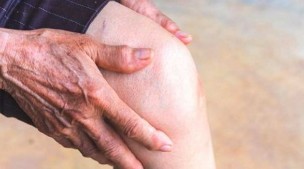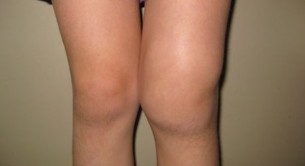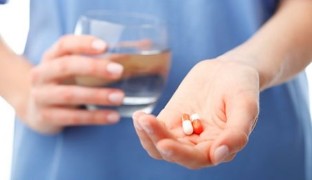Osteoarthritis of the knee joint (gonarthrosis) – is a disease characterized by degenerative-degenerative changes in cartilage, meniscus, and bones forming the knee joint. The disease takes a leading place among the pathology of the musculoskeletal system.

The reasons gonartrózaa
Osteoarthritis of the knee is a polyetiological disease, i.e. a condition where the development of pathological changes support several causal factors. In this case, one speaks of primary (idiopathic) osteoarthritis. When the secondary gonartrózae has the exact factor, which causes the disease.
The main reasons of arthritis include:
- a knee injury;
- surgical procedures in the area of the knee joint;
- increased physical burden;
- overweight, obesity;
- congenital pathology of the lower extremities;
- syndrome systemic connective tissue dysplasia;
- disorders of the metabolism;
- general diseases (diabetes mellitus, rheumatoid arthritis, acromegaly).
Important!
The impact of the traumatic agent is the main cause of osteoarthritis in young age. To a knee injury, the leading osteoarthritis, include sprains, fractures or damage to the meniscus.
On the basis of the development of pathological changes is the need for mobilization of the joint after the injury, it contributes to the deterioration of blood circulation in periarticular tissues, which, together with the available mechanical damage leads to long-term regeneration and development of the symptoms of arthrosis.
Increased physical activity is manifested not only in intensive courses of exercise, but also in the presence of excess weight. Being overweight and exercise, it is not appropriate to the age and level of physical readiness of the person, leading to the formation of cracking on the skin, or menisci, that is the first article in the process of forming gonartrózaa.
Congenital pathology of the lower extremities, which includes shortening one of the limbs, hip dysplasia, and also a valgus or varus deformation of the feet leads to the formation of arthrosis, because of the uneven distribution of the weight of a person. In consequence, the disappearing of the cartilage, forming a fireplace of aseptic inflammation with the appearance of typical clinical signs of arthrosis.
Syndrome systemic connective tissue dysplasia characterized by hyper-mobility of the kidney and the ligamentous apparatus. Which in the joint increases the amplitude of the movements, until after a pathological. This instability quickly leads to the formation of trauma to the meniscus and the surfaces of the cartilage.
Metabolic disorders and the availability of spo-somatic pathology provokes the development of arthrosis due to violation of the microcirculation in the knee joint, deterioration of the nutrition of the cartilage and meniscus, the deterioration of the composition of the intra-articular fluid.
Classification
Code according to ICD 10 – M17. Depending on the etiological factors that the emergence of arthrosis, issued to the following categories:
- M17.0 – primary gonarthrosis bilateral;
- M17.1 other primary gonarthrosis;
- M17.2 post-traumatic gonarthrosis bilateral;
- M17.3 – other post-traumatic gonarthrosis;
- M17.4 – other secondary gonarthrosis, bilateral;
- M17.5 – other secondary gonarthrosis;
- M17.9 – gonarthrosis is not refined.

Be issued with the following types of arthrosis of the knee joint:
- involutional – arises as a result of age changes of an organism, disturbances of metabolic processes, fraying of the articular surfaces of the bones;
- dysplastic – is associated with congenital anomalies of the lower limbs;
- post-traumatic;
- metabolic – occurs when total diseases accompanied by metabolic disorders (gout, chondrocalcinosis);
- dishormonal – manifests in hormonal imbalance in the body in diabetes, menopause, disorders of the functioning of the thyroid gland;
- after-inflammatory – arises after infectious-inflammatory diseases of the knee joint;
- static – manifested in the excessive physical exertion, poor weight distribution, obesity;
- ischemic – is associated with impaired blood supply to the area of the knee.
Pathological
The disease develops gradually. The first changes appear in Podhradie layer – formed hairline cracks. The emergence of cracking raises the constant work of the knee joint, one of the functions, which is the amortization of the shocks when walking. And with the presence of etiologic factors the load on the knees increases even more, and the processes of destruction begin to exceed the processes of recovery of the cartilage, causing cracks to appear.
Subsequently, hairline cracks penetrates the synovial fluid and form cysts, which tend to increase and the merger. Large cysts begin to squeeze the blood vessels nourishing the cartilage, which leads to a lack of oxygen starvation of the cartilage. Violated the metabolic processes, impairs the synthesis of collagen, necessary for rebuilding cartilage. With regard to the bad recovery of the cartilage, leads to its gradual thinning, which leads to disruption of the function of the joint, appear the clinical symptoms of the disease.
On the note!
In the progression begin to form osteophytes – bony growths. Osteophytes predominantly are located on the edges of the articular surfaces of the bones. Their presence provokes a distinctive inflammatory response in the joint, pain, deformation of the joint, a considerable restriction of motion.
In the development of the inflammatory process is observed swelling of the tissue, which leads to increased pressure in the joint, worsening the composition of the intra-articular fluid is disturbed nutrition of the cartilage.
Clinical symptoms
In the course of the disease are issued to several degrees of arthrosis, which reflect the process of progression of pathological changes and have certain clinical manifestations.
The symptoms of the arthrosis of the knee joint is adopted to divide the stage:
- In the initial stage of the disease is characterized by the occurrence of painful sensations in the knee area, especially after intense physical exertion or prolonged stay on the feet. Less favorable static load, then the lifting of weights. Soreness in the joint takes place independently after the rest. In addition to pain may occur distress or click in the joint, indicating a violation of the conformity of the joint surfaces of the bones forming the joint, and the occurrence of cracking on the skin. Missing sharply expressed clinical symptoms leads to the fact that the majority of patients does not seek medical help at the initial stage, which leads to late diagnosis.
- The progression of the disease leads to the formation of more pronounced pain syndrome – pain arises even after a moderate load, by yourself will not pass. There is morning stiffness in the joint, lasting about 30 minutes, but if they join inflammation, stiffness can then take up to 1 hour. Because of the significant pain a person begins investigating the foot, reduces the amplitude of movements, appears claudication. Due to swelling of the tissues of the knee increases in volume. Appear radiological signs of arthrosis of the knee joint.
- The formation of osteophytes characterized by the development of 3 stage of the disease, which is strongly expressed painful even at rest, poorly jugulate medicines. The movement is virtually absent, the joint deformed. Possible interference of the knee joint in a certain position, as well as dislocation or subluxation.

Diagnostic examination
The diagnosis of osteoarthritis consists of several components:
- The complaints of the patient.
- The history of the development of the disease.
- The history of the life of the patient.
- Laboratory and instrumental methods of research.
On the basis of complaints of patient and anamnesis of life and illness, the doctor puts the preliminary diagnosis. But for the execution of the differential diagnosis with other pathologies and to establish an accurate diagnosis is necessary laboratory and instrumental methods.
To instrumental methods of examination of the knee joint include:
- radiography;
- arthroscopy;
- computed tomography;
- ultrasound examination;
- magnetic-resonance tomography.
Important!
The main instrument for the diagnosis of osteoarthritis is x-ray examination. The x-ray image of the knee joint is carried out in two planes that gives a complete picture of the existing changes. It is important to note that in the initial stages of osteoarthritis in the photo is not uploaded.
On the basis of the detected x-ray signs is built x-ray classification gonartrózaa:
- 1 degree – mild narrowing of the joint space;
- 2 degree – moderate joint space narrowing, the presence of a bone seal;
- 3 degree – expressed as joint space narrowing, presence of osteophytes, initial signs of bone deformation;
- 4 degree – expressed as joint space narrowing, until its complete absence, numerous osteophytes, destruction of bone tissue, deformation of the joint.
Other methods of examination of the knee joint are in addition to the basic x-ray studies. And held as additional diagnosis when embarrassed, in establishing the diagnosis.
Each of the methods of diagnosis has its indications, contraindications and different value, so necessarily must set apart a specialist, if necessary.
How to treat arthritis of the knee joint
Treatment of arthrosis of the knee joint, it is necessary to start at the occurrence of first clinical symptoms of the disease. Modern treatment of arthrosis of the knee is aimed at restoring joint function and improve the quality of life of patients and is the following:
- termination or reduction of painful feelings;
- treatment of the inflammatory process;
- restore the structure of the cartilage;
- increase range of motion;
- improve the microcirculation of the periarticular tissue.

On the note! It is important to note that in the different stages of applying various methods of treatment. If the time to start to fight with the disease, then you can get rid of not only from the painful feelings, but also to restore the knee joint in osteoarthritis, as well as prevent the occurrence of complications.
Used drug therapy helps to reduce pain and the inflammatory response, this is achieved by using non-steroidal anti-inflammatory drugs. For the recovery of the cartilage are appointed by the chondroprotector. Scheme of treatment is prescribed and monitored by a doctor.
In the appendix to drug treatment appointed physiotherapy, ointments, gymnastics, massage or intra-articular injection of drugs.
Than treatment of osteoarthritis of the knee joint
In this case, it is permitted to receive the gelatin, which can be taken orally or make a compress. People's medicine is not appointed as a monotherapy, and to be a part of complex treatment activities. Before that, how to start a similar treatment at home, it is necessary to familiarize with recommendations and reviews.
Is it possible to cure arthritis
In poor or delayed treatment of the consequences of disease progression are not forced to wait. Gonarthrosis is dangerous by the fact that even proper treatment can completely stop the process, and only inhibit it, but it allows a person to a longer period of time to maintain activity.
If the disease came up to the severe stage, then conservative treatment becomes ineffective. When 3 phase spend surgical treatment, after which it is required long-term rehabilitation.




























